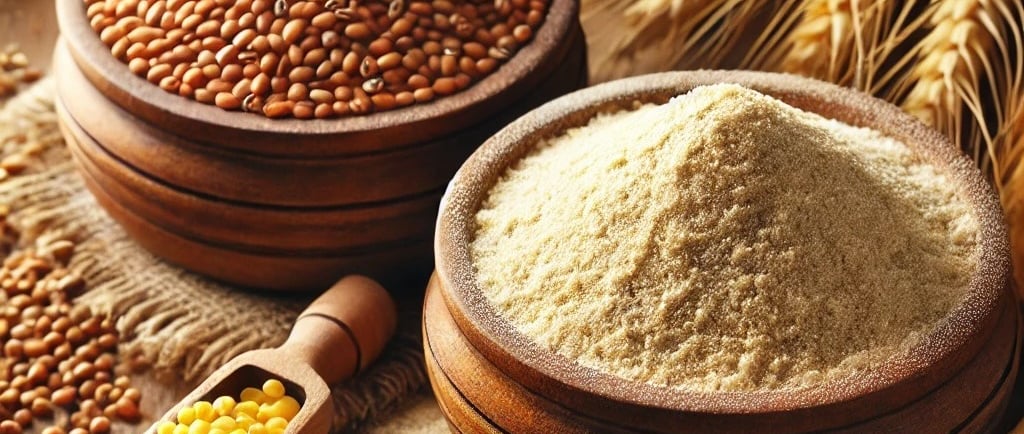Unlocking the Power of Bajra Flour (pearl millet): A Nutrient-Rich Alternative to Wheat
Switching to bajra flour from wheat flour can lead to numerous health benefits while still providing the versatility needed for everyday meals like flatbreads, porridge, and baked goods.
Golden Gate FAB
10/13/20243 min read


Bajra (also known as pearl millet) is a highly nutritious grain that has been a staple in various parts of the world, particularly in India and Africa, for centuries. Bajra flour, made from ground pearl millet, offers several health benefits, making it an excellent alternative to wheat flour. With growing awareness of healthy eating, more people are switching to alternative grains like bajra for a more diverse and balanced diet.
Below are some key benefits of bajra flour over wheat flour:
1. Rich in Nutrients
Bajra flour is packed with essential nutrients that make it more nutritious than traditional wheat flour in many ways:
Higher Fiber Content: Bajra is a rich source of dietary fiber, which aids digestion, prevents constipation, and promotes a healthy gut. In comparison, wheat flour, especially refined wheat (maida), has lower fiber content.
Rich in Iron: Bajra contains more iron than wheat, which is beneficial for preventing anemia and promoting healthy blood circulation.
Magnesium: Bajra is rich in magnesium, which helps regulate blood pressure, supports heart health, and improves bone strength.
Phosphorus and Potassium: These essential minerals help in bone formation and maintaining electrolyte balance in the body.
2. Gluten-Free Option
One of the most significant advantages of bajra flour is that it is naturally gluten-free, making it an excellent choice for individuals with celiac disease or gluten intolerance. On the other hand, wheat flour contains gluten, which can trigger inflammation or digestive problems for those with gluten sensitivity. For people seeking a gluten-free lifestyle, bajra flour provides a healthy and wholesome alternative to wheat flour.
3. Lower Glycemic Index
Bajra has a lower glycemic index (GI) compared to wheat flour, meaning it causes a slower, more gradual rise in blood sugar levels after consumption. This makes bajra flour a better option for diabetics or those looking to manage their blood sugar levels. The lower GI helps in:
Preventing sugar spikes: Bajra is absorbed more slowly by the body, preventing sudden sugar spikes and crashes.
Sustained energy: It provides more sustained energy release over time, which is useful for maintaining steady energy levels throughout the day.
4. Supports Weight Management
Due to its high fiber content, bajra flour promotes a feeling of fullness and helps control hunger cravings. This makes it an ideal grain for those looking to manage their weight. The slow digestion of bajra helps keep one satiated for longer periods, reducing the likelihood of overeating.
Wheat flour, particularly refined wheat flour, can lead to rapid digestion and spikes in hunger, making it harder for people to maintain a healthy weight. Incorporating bajra flour into the diet is a natural way to enhance satiety and aid in weight loss or maintenance.
5. Promotes Heart Health
Bajra contains heart-healthy fats and is rich in magnesium, which help regulate cholesterol levels and blood pressure. The high fiber content also contributes to better heart health by reducing the absorption of bad cholesterol (LDL) in the body. Wheat flour, particularly refined versions, can contribute to higher cholesterol and blood sugar levels due to its rapid digestion.
By replacing wheat flour with bajra flour, individuals can benefit from:
Improved cholesterol profiles.
Reduced risk of cardiovascular disease.
Better blood pressure control.
6. Helps in Managing Digestive Health
Bajra flour is easier to digest than wheat flour, especially for people with gluten sensitivity or digestive issues. The fiber content in bajra acts as a natural laxative, which can help prevent digestive problems like constipation, bloating, and irritable bowel syndrome (IBS). In comparison, wheat, mainly processed wheat products, can sometimes lead to bloating or discomfort in individuals with gluten sensitivity.
7. Antioxidant Properties
Bajra is a rich source of antioxidants, including polyphenols and phytochemicals, which help in fighting free radicals and reducing oxidative stress in the body. This contributes to overall health and helps reduce the risk of chronic diseases like cancer. Wheat flour, on the other hand, has fewer antioxidants compared to bajra flour.
8. Improves Skin and Hair Health
Thanks to its nutritional profile, bajra flour supports healthy skin and hair. Its high content of vitamins and minerals like zinc and B-complex vitamins helps rejuvenate skin and promotes healthy hair growth. These micronutrients affect skin elasticity, moisture retention, and overall skin health.
Conclusion
In summary, Bajra flour is a superior alternative to wheat flour in many aspects, especially for those with specific dietary needs like gluten intolerance or diabetes or those seeking to improve their heart health or manage their weight. Its high fiber, nutrient density, and gluten-free nature make it an excellent choice for diversifying their diet with healthier grain options.
Join our WhatsApp Group to stay updated with exciting announcements, exclusive offers, and the latest deals on your favorite Indian grocery items.
Refund Policy: All sales are final. No Exchange, No Refund, No Return
Contact US
desitozllc@gmail.com
+1 925-744-2658
© 2024. All rights reserved.
